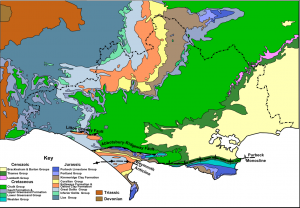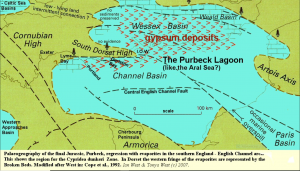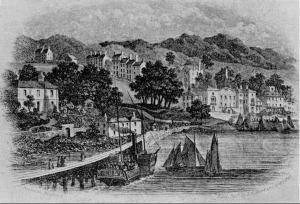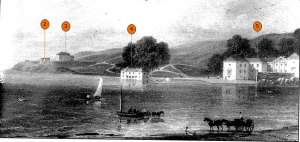Introduction to Historical Topics and People
Swanage and the Isle of Purbeck History
This site explores Swanage and the Isle of Purbeck from 1066 to the 20th Century
Swanage at the time of the 1891 Census, had a population of 2,674 and approximately 300 worked in the Stone trade.
This site is divided into three major topics, the Development of the Stone Trade, the Entrepreneurs who developed the area into a seaside resort and the 19th century Geograpy of the Swanage area. The information has been rationalised into an Introduction with a more technical development of a particular sub-topic in the sidebars.
Introduction to Portland and Purbeck Stone
There are numerous examples of old open cast quarries on the Isle of Purbeck, one example is the base of the Peveril Car Park and the incline leading to the top of the downs. This was created before the Norman invasion (1066) when a large section of the Isle of Purbeck was under the custody of the Abbess of Shaftesbury. The material extracted was building stone, known as Burr or Butter stone and a layer of marble running up from Peveril Ledge. The rock was quarried by other ecclesiastical houses, such as Winchester, Romsey, Christchurch, Wimborne and Salisbury and shipped to these destinations on barges. Consequently, this created a huge open cast quarry, which is still evident today in the steep banking of the car park perimeter 3.
The Abbess had considerable authority over her territories, for example when William the Conqueror wanted to build Corfe Castle in 1070 he had to negotiate land access. The Domesday survey records state that the Abbess of Shaftesbury gave Castle Hill and a strip of land to William the Conqueror for his castle in return for the church at Gillingham.
John Mowlem
John Mowlem learnt his masonry skills from his father John who worked the stone mined from an area west of Swanage called Common Fields. He was the eldest boy from a family of six who lived at Carrants Court
In 1806-7, John Mowlem a Swanage resident moved to the Isle of Wight to develop his skills by taking a job at Norris Castle Quarry on the Isle of Wight. Whilst there a sculptor/mason James Wyatt was impressed by Mowlem’s work and recommended him to Henry Westmacott, a well known sculptor-mason in London. Mowlem jumped at the opportunity and moved to London and worked for him.
At this time the Government masons works had contracts for work at Greenwich and Kensington Palaces, the Royal Mews and Somerset House. For all these contracts in the capital Mowlem was made foreman over all the workers in 1816.
In 1823 he set up a business of his own where he leased a wharf in Pimlico Basin, now the site of Victoria Station forecourt and started his own business importing Purbeck Limestone, York sandstone and Aberdeen granite. Later he moved to offices and a yard at Paddington Basin next to the Grand Union Canal, this remained his headquarters for the rest of his life.
His company had its first major job with a contract to re-pave Blackfriars Bridge with Guernsey granite setts. To ensure a reliable supply he bought an acre of land in Guernsey, in the north of the island and moved there to supervise the removal and shipping to London, until the task was completed in June 1840.
William Morton Pitt
From extracts of his obituary published in The Gentlemen’s Magazine, Volume 15, January to June 1836.Mr. W. Morton Pitt was the eldest and only surviving son of John Pitt, esq. of Encombe, a Commissioner of Trade and Plantations, Surveyor of Woods and Forests, and M. P. for Wareham and Dorchester. In 1779, Mr. Morton Pitt was appointed Lieut-Col. of the Dorsetshire Militia. He lived at the mansion-house at Encombe in the Isle of Purbeck, which Mr. Pitt inherited from his father. The estate of Kingston had belonged to his uncle William Pitt, Esq. who died in 1773. William Morton Pitt (1754-1836) a cousin of the Prime Minister William Pitt (the younger) born (1759-1806), was essentially a public man, throughout a long and laborious life.
Mr. Pitt had the rare success of obtaining the good will of, and giving satisfaction to, all classes and parties; and whether as an active county magistrate, the duties of which office he fulfilled with zeal, ability and discretion, for upwards of half a century; or in parliament, where he sat for the Poole Constituency 1780-1790 and later the Dorset Constituency 1790-1826. His time and exertions unremittingly devoted to the public good. Nor was his private life less worthy. Beloved by his family, esteemed by his friends, and honoured by all, he passed through life distinguished by the possession of the purest virtues, and by the exercise of a diffusive philanthropy, and extensive practical benevolence.
The double barrelled name Morton was derived from a distant relative his great-great grandmother; the wife of Edward Pitt Esq of Stratfieldsaye, (married in 1620) having been Rachel, daughter of Sir George Morton of Milbourne, St. Andrew. Mr Morton Pitt was a member of Queen’s college, Oxford and matriculated March 17, 1772: but quitted the university without taking a degree 13 .
1830 Peveril Point, (2)Preventative Station, (3)Alpha Cottage, (4)Marine Villa and (5)Manor House Hotel
In1825, William Morton Pitt built Marine Villas, the stone quay extension, the house opposite the hotel named the Rookery and the Royal Victoria Hotel modifications.
In 1832, the four terrace houses half-way up the hill on Seymer road.
Pitt financed the proposed building of 13 houses in Seymer road under the Tontine principle, this was a scheme where shares in the project were sold to subscribers. The first eight subscribers paid £100 each, by August 1831 there were 22 subscribers. By June 1832, three houses were built and ready to be let unfurnished 4 .



